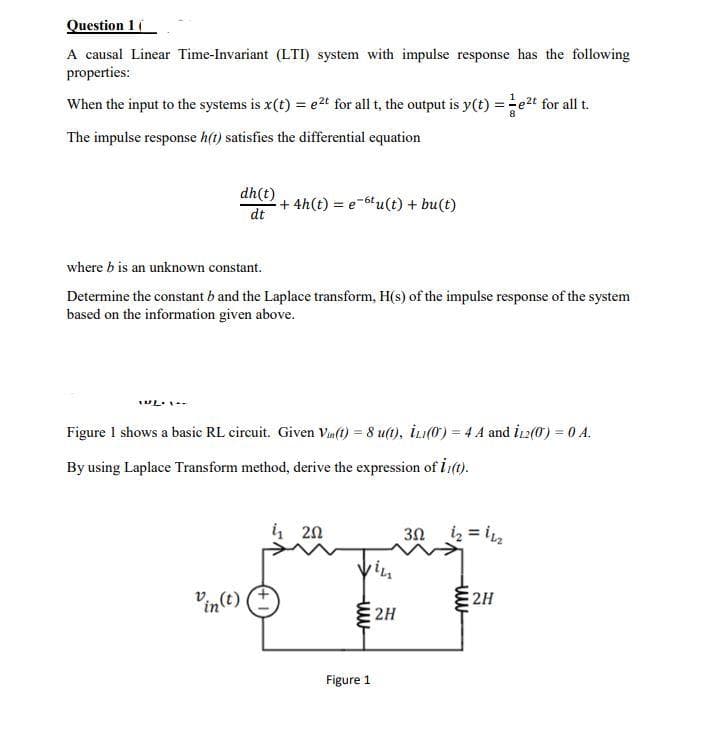Question 1 A causal Linear Time-Invariant (LTI) system with impulse response has the following properties: When the input to the systems is x(t) = e2t for all t, the output is y(t) =e2t for all t. The impulse response h(t) satisfies the differential equation dh(t) + 4h(t) = e-6u(t) + bu(t) dt where b is an unknown constant. Determine the constant b and the Laplace transform, H(s) of the impulse response of the system based on the information given above.
Question 1 A causal Linear Time-Invariant (LTI) system with impulse response has the following properties: When the input to the systems is x(t) = e2t for all t, the output is y(t) =e2t for all t. The impulse response h(t) satisfies the differential equation dh(t) + 4h(t) = e-6u(t) + bu(t) dt where b is an unknown constant. Determine the constant b and the Laplace transform, H(s) of the impulse response of the system based on the information given above.
Introductory Circuit Analysis (13th Edition)
13th Edition
ISBN:9780133923605
Author:Robert L. Boylestad
Publisher:Robert L. Boylestad
Chapter1: Introduction
Section: Chapter Questions
Problem 1P: Visit your local library (at school or home) and describe the extent to which it provides literature...
Related questions
Question

Transcribed Image Text:Question 1 (
A causal Linear Time-Invariant (LTI) system with impulse response has the following
properties:
When the input to the systems is x(t) = e2t for all t, the output is y(t) =e2t for all t.
The impulse response h(t) satisfies the differential equation
dh(t)
+ 4h(t) = e-6u(t) + bu(t)
dt
where b is an unknown constant.
Determine the constant b and the Laplace transform, H(s) of the impulse response of the system
based on the information given above.
Figure 1 shows a basic RL circuit. Given Vim(t) = 8 u(t), ii(0) = 4 A and i2(0) = 0 A.
%3D
By using Laplace Transform method, derive the expression of i(t).
4 20
iz = i
Vin(t)
E2H
2H
Figure 1
Expert Solution
This question has been solved!
Explore an expertly crafted, step-by-step solution for a thorough understanding of key concepts.
Step by step
Solved in 3 steps with 2 images

Knowledge Booster
Learn more about
Need a deep-dive on the concept behind this application? Look no further. Learn more about this topic, electrical-engineering and related others by exploring similar questions and additional content below.Recommended textbooks for you

Introductory Circuit Analysis (13th Edition)
Electrical Engineering
ISBN:
9780133923605
Author:
Robert L. Boylestad
Publisher:
PEARSON

Delmar's Standard Textbook Of Electricity
Electrical Engineering
ISBN:
9781337900348
Author:
Stephen L. Herman
Publisher:
Cengage Learning

Programmable Logic Controllers
Electrical Engineering
ISBN:
9780073373843
Author:
Frank D. Petruzella
Publisher:
McGraw-Hill Education

Introductory Circuit Analysis (13th Edition)
Electrical Engineering
ISBN:
9780133923605
Author:
Robert L. Boylestad
Publisher:
PEARSON

Delmar's Standard Textbook Of Electricity
Electrical Engineering
ISBN:
9781337900348
Author:
Stephen L. Herman
Publisher:
Cengage Learning

Programmable Logic Controllers
Electrical Engineering
ISBN:
9780073373843
Author:
Frank D. Petruzella
Publisher:
McGraw-Hill Education

Fundamentals of Electric Circuits
Electrical Engineering
ISBN:
9780078028229
Author:
Charles K Alexander, Matthew Sadiku
Publisher:
McGraw-Hill Education

Electric Circuits. (11th Edition)
Electrical Engineering
ISBN:
9780134746968
Author:
James W. Nilsson, Susan Riedel
Publisher:
PEARSON

Engineering Electromagnetics
Electrical Engineering
ISBN:
9780078028151
Author:
Hayt, William H. (william Hart), Jr, BUCK, John A.
Publisher:
Mcgraw-hill Education,